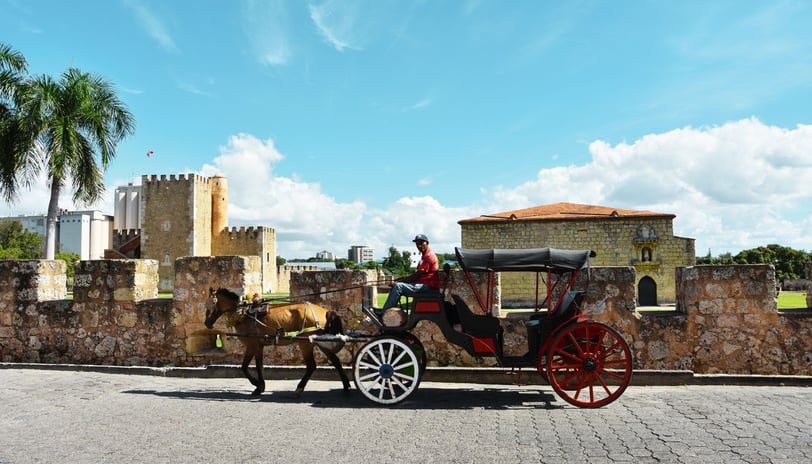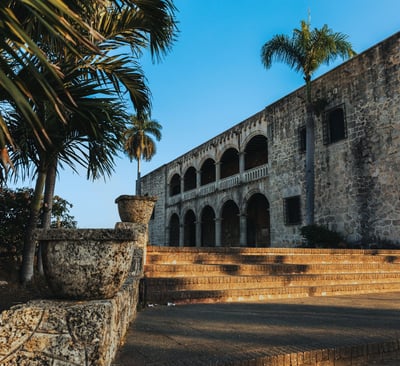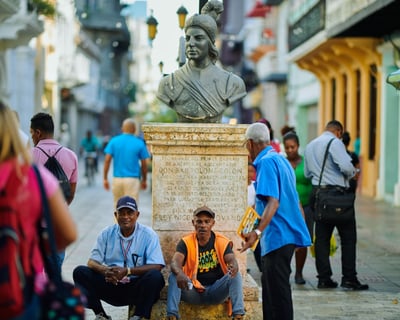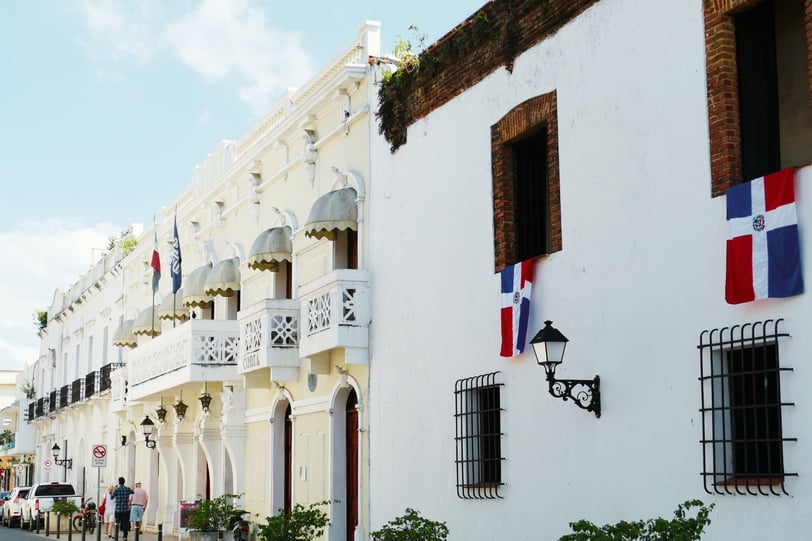Santo Domingo Travel Guide: The First City of the New World


A Caribbean Heartbeat of History and Rhythm
Photo by Phyrexian - Own work, CC BY-SA 4.0
Zona Colonial: Historic Treasures of the New World
The Zona Colonial, Santo Domingo’s historic heart, is a UNESCO World Heritage Site where time seems to pause. Cobblestone streets wind past 16th-century buildings, their pastel facades glowing under the Caribbean sun. Parque Colón, the district’s lively square, buzzes with street vendors and the chatter of locals beneath the gaze of Christopher Columbus’s statue.
Key landmarks include the Catedral Primada de América, the Americas’ first cathedral, blending Gothic and Baroque splendor. Nearby, the Alcázar de Colón, once home to Diego Colón, offers a glimpse into colonial opulence. The Fortaleza Ozama, the oldest military fort in the Americas, stands sentinel over the Ozama River, while the Panteón de la Patria honors national heroes. “Every stone here tells a story,” says a local guide, her voice mingling with the clink of coffee cups in a nearby café.
Perched on the southern coast of the Dominican Republic, Santo Domingo pulses as the oldest European city in the Americas, founded in 1496 by Bartholomew Columbus. A UNESCO World Heritage Site, its cobblestone streets and coral-stone facades hum with the echoes of Spanish conquest, Taíno heritage, and modern Caribbean vibrancy. From the first cathedral in the New World to the infectious rhythms of merengue, Santo Domingo weaves a tapestry where past and present dance in seamless harmony.


Cultural Icons: Voices of Art and Independence
The Malecón: Where Sunset Meets Merengue
Stretching along the Caribbean Sea, the Malecón is Santo Domingo’s vibrant waterfront. Palm trees sway, restaurants serve fresh ceviche, and merengue spills from open-air bars. At sunset, the sky blazes orange, casting a glow over couples strolling and musicians strumming bachata. “The Malecón is where we come alive,” says a street vendor, offering a cold Presidente beer.
This boulevard blends history—monuments like the Obelisk—with modern life, making it a perfect spot to feel the city’s pulse. Whether dining or dancing, the Malecón captures Santo Domingo’s irrepressible spirit.
Santo Domingo has nurtured visionaries who shaped Dominican identity. Poet Pedro Mir, the nation’s literary voice, wove tales of struggle and hope. Painter Candido Bidó captured the Caribbean’s vibrancy in bold colors. Juan Pablo Duarte, the father of Dominican independence, ignited the 1844 liberation from Haiti. Philosopher Pedro Henríquez Ureña elevated Hispanic literature, his ideas resonating across Latin America.
These icons echo in the city’s galleries and streets, where art and history intertwine. For travelers, exploring their legacies—through museums or murals—feels like a conversation with Santo Domingo’s soul.
Rhythms and Flavors: Merengue, Bachata, and La Bandera
Santo Domingo breathes music. Merengue and bachata, born here, fill plazas and clubs, inviting visitors to sway alongside locals. The Merengue Festival (July) transforms the city into a kaleidoscope of dance and color, a must for cultural explorers.
Food is equally vibrant. Mangu, mashed plantains with onions, starts the day, while La Bandera Dominicana—rice, beans, and stewed meat—fuels lunch. For dessert, try dulce de leche at a Zona Colonial café. Modern eateries like Adrian Tropical fuse Caribbean flavors with global flair, delighting foodies.


Santo Domingo Today: A City of Past and Promise
Practical Pleasures
To immerse in Santo Domingo’s historic and rhythmic charm in 2025, here are curated details with specific recommendations and costs:
How to Get There:
By Air: Fly to Las Américas International Airport (SDQ), 30 min from Zona Colonial. Flights from Miami (~USD 200–400 round trip) or New York (~USD 300–500). Taxis to the city cost ~USD 30; Uber is ~USD 20. Book via uber.com.
By Bus: From Punta Cana (2.5h, ~USD 10) or Santiago (2h, ~USD 8) via Caribe Tours (caribetours.com.do).
Local Transport: Zona Colonial is walkable. Taxis within the city cost ~USD 5–10. Rent bikes (~USD 15/day) or use Metro Line 1 (~USD 0.60/ride) for outer areas.
Where to Stay:
Billini Hotel (Zona Colonial): Boutique hotel with colonial charm, ~USD 120–180/night. Rooftop views, perfect for couples.
Casas del XVI (Zona Colonial): Historic guesthouse with courtyards, ~USD 150–250/night. Ideal for history buffs.
Hostal Bella Epoca (Zona Colonial): Budget-friendly, ~USD 40–60/night. Great for solo travelers.
Hodelpa Nicolás de Ovando (Zona Colonial): Luxury in a 16th-century mansion, ~USD 200–350/night. Book early for riverfront rooms.
Where to Eat:
Mesón D’Bari (Zona Colonial): Sancocho and grilled snapper, ~USD 10–20/person. Vibrant, artsy vibe.
Adrian Tropical (Malecón): Mangu and seafood mofongo, ~USD 8–15/person. Oceanfront dining.
Café del Parque (Parque Colón, Zona Colonial): Empanadas and coffee, ~USD 3–6. Perfect for quick bites.
La Dolcerie (Gazcue): Dulce de leche desserts, ~USD 5–10. Family-friendly.
What to Do:
Catedral Primada Tour: Guided tour of the Americas’ first cathedral, ~USD 5/person. Book at the cathedral’s ticket office.
Alcázar de Colón Visit: Explore Diego Colón’s palace, ~USD 3/person. Open 09:00–17:00. Purchase tickets on-site.
Museo del Hombre Dominicano: Dive into Taíno and Dominican heritage, ~USD 4/person. Located in Plaza de la Cultura; visit the ticket office for details.
Merengue Festival: Join July’s street dances, free entry. Check visitdominicanrepublic.com for dates.
Artisan Market Stroll: Browse handmade jewelry and paintings at Mercado Modelo, free. Ideal for slow travelers seeking local crafts.
Sketch in Parque Colón: Set up a sketchbook or camera in Zona Colonial’s lively square, a favorite for artists capturing Caribbean life. Free, perfect for creative souls.
Jam with Locals: Join musicians at Plaza España’s open-air sessions, free. Bring a guitar or dance along, great for music lovers.
Best Time to Visit:
December–April offers warm, dry weather (25–30°C), ideal for walking and festivals. Avoid hurricane season (June–November) for fewer storms.
Who Will Love It:
Solo travelers craving culture, couples seeking romance, families exploring history, adventurers chasing rhythms, and slow-living creatives inspired by art and heritage.
Budget Overview:
A one-week trip for two averages ~USD 1,600, covering mid-range accommodation (~USD 100/night), meals (~USD 15–30/day/person), transport (~USD 30/day), and activities (~USD 20–50/person). Budget travelers can spend ~USD 60/day/person.
Despite drawing 1.5 million visitors annually, the Zona Colonial retains its Dominican soul—locals sip coffee in centuries-old courtyards, and street art blooms alongside historic walls. Sustainable tourism initiatives, like guided walking tours, support preservation, ensuring the city’s heritage endures.
To capture its magic, wander the Zona Colonial at dawn, when streets are quiet, or join the Malecón’s evening revelry. To weave your own story into Santo Domingo’s vibrant tapestry, here’s what you need to know for your 2025 journey.


Santo Domingo at a Glance
Where Rhythms Resound
Beyond its historic landmarks and title as the New World’s first city, Santo Domingo holds quieter, hidden stories that speak in whispers. Step into one such tale in Travelers' Tales — "The Bookseller of Calle Hostos: A Santo Domingo Tale."
While memory lingers in stone and shadow, the city pulses forward. Witness the unfolding transformation of Santo Domingo in Travel Insights — "Santo Domingo 2025: Colonial Echoes, Afro-Caribbean Spirit, and Urban Renaissance."
Santo Domingo beckons with history and heart—romantics dancing on the Malecón, adventurers tracing colonial forts, creatives sketching in Parque Colón. From the Zona Colonial’s ancient stones to merengue’s infectious beat, the city hums with stories of resilience and joy.
Join a cathedral tour (USD 5), visit the Museo del Hombre Dominicano (USD 4), or jam with locals at Plaza España to weave your thread into Santo Domingo’s vibrant tapestry. Plan your 2025 journey, where Caribbean rhythms await your story. In the glow where sea meets sunset, Santo Domingo offers a timeless dance of old and new.
✉️ Contact:
Curated by TrueTrip Hub |
© 2025 Invisible Atlas — All rights reserved.
Invisible Atlas
Journey Beyond the Visible
invisible.atlas@truetriphub.com
